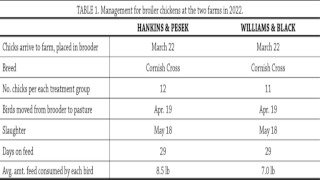To determine the effect of replacing corn with oats in the ration, Hankins & Pesek and Williams & Black compared two rations: (1) typical ration, consisting of corn, soybeans, vitamins and minerals; and (2) oat ration, in which 10% of the corn in the typical ration was replaced with oats. The typical ration was ground by and sourced from D&J Feeds (Hopkinton, IA) and cost $0.30/lb. The oat ration was ground at Sundog Farm (Solon, IA) and included a vitamin mix from Heritage Poultry VTM in order to balance the vitamins and minerals in each ration. The oat ration ended up costing less than the typical ration ($0.27/lb).

Both farms received 100 chicks in March and placed them in brooders. When it came time to move the birds to pasture, each farm divided their flocks in two: randomly assigning 50 birds to receive the typical ration and 50 birds to receive the oat ration. Both farms then selected a subset of birds to monitor from each of the two treatment groups. At Hankins & Pesek’s, chickens were raised on pasture using an “open cell system” meaning they are in electric netting with free will access to trees or shade structures but are not in tractors and do not get closed in a shelter at night. At Williams & Black’s, each treatment group was placed in separate chicken tractors on pasture. Apart from the rations, chickens were managed similarly, raised in separate enclosures on pasture and receiving equal access to feed and water. More management information for each farm is provided in Table 1. At Hankins & Pesek’s, chickens were offered the same amount of feed every day from either ration (roughly 0.3 lb feed/bird/day). At Williams & Black’s, chickens were offered 0.1 lb feed/bird/day from Apr. 19 to May 2 and were offered 0.4 lb feed/bird/day from May 3 to May 17.
Conclusions and Next Steps
The cooperators went into the trial thinking the oat ration would be more expensive than the typical ration but that broilers fed the oat ration would perform better. For Hankins and Pesek, it turned out that the oat ration cost less than the typical ration and that broilers fed either ration performed similarly. “I’m so excited about this trial because it means we’ve done so much poultry math this spring and we are so much more in the know about our own cost analysis when it comes to feed and we have improved our production tremendously by making more observations about access to feed and why increasing our efficiency is so important,” Hankins said of their trial. She also remarked that the very act of monitoring broiler gain on pasture was valuable to their operation. “In a pasture setting there are many factors out of our control but this trial made us think about the factors that are in our control and how we best keep them consistent.” Black found it interesting that they saw different results from Hankins & Pesek’s farm and the trial also helped her realize the most appropriate strategy going forward: “Even if there had been a difference in rate of gain or cost [between the rations], we currently do not have the infrastructure to continue grinding our own rations, making the typical ration still a more affordable and convenient choice.”
Click here to see more...